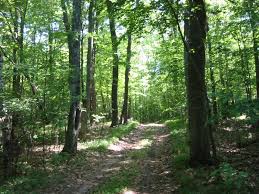Trees and forest
Submitted by obbadmin on Wed, 11/01/2017 - 15:59
The book ‘The hidden life of trees’ by Peter Wholleben changed the way I look at trees.
The book tells how individual trees from the same species of tree, growing in the same stand (e.g. small group of trees), are connected to each other by their roots. They use this network to exchange nutrients and give warning if one is being attacked by insects.
More closely related trees give each other more support than distant relatives.

Older trees nurture their saplings.
If the roots of trees get disturbed they can’t connect with each other to help each other out.
The roots of individual trees spread out to more than two times the spread of the crown…
All the trees in the forest, of all kinds of species, are connected through a network of fungi or mycelium. Information and nutrients also gets exchanged through this system.
You will find 2 times the amount of life-giving Nitrogen and phosphorus in trees that cooperate with fungal partners, than in plants that tap the soil with their roots alone!
It is hard to start growing a forest on cultivated ground, because the fungi network won’t be there. It takes many years (over 100!) for that to form naturally.
Gaps in the tree canopy are a danger to forests because they make it easier for storms to uproot trees; the heat of summer can get in, drying out the forest floor; and if sunlight reaches the forest floor, humus is used up faster than it is produced. That is why the forest community supports its members.
Baby trees growing slowly, in the shade of their parents, grow much stronger, with denser wood than trees growing in the light. This means they are less vulnerable to pests and diseases (fungi and bacteria) and to storm damage as well.
Fertilizer, artificial or otherwise, makes the trees grow faster. Just like with the growth caused by getting more sun, this weakens the tree, because the wood is softer, making it more vulnerable than that of trees that grow slowly.
Forest trees are healthier when they are growing close together. They need shade and the support from their neighbours.
What I know as ‘bi-annuallism’, from fruit-growing, is in fact a natural system to regulate the number of animals that feed on the seed and nuts of trees. It ensures animals can’t rely on the harvest every year and populations don’t keep growing, eating all the seeds that the trees produce.
Genetic diversity is crucial for trees: every tree in a natural forest is genetically different from its neighbours. This makes the forest as a whole better able to adjust and thrive. If the world gets drier, hotter, or colder, different trees will be better able to deal with those different circumstances, giving the forest more chance to survive.
When we import trees, their population has less genetic variety, making it harder for them to adapt, especially in a habitat that was not where they evolved in to start with.
The older a tree, the faster it grows. Keeping old trees is a better measure against climate change than planting new ones.
The forest floor needs to be loose, so water slowly seeps down and becomes groundwater, staying available to the trees, instead of running off and disappearing. It is also important to have loose ground around the trees roots, because they breathe through their roots, especially in winter, when they can’t do this with their leaves.
 Brambles and shrubs, as well as invasive weeds like hog-weed and Japanese knotweed and so on, can only grow in a forest if there are gaps in the canopy and sunlight reaches the forest floor. This is not the natural situation (in our temperate climate at least).
Brambles and shrubs, as well as invasive weeds like hog-weed and Japanese knotweed and so on, can only grow in a forest if there are gaps in the canopy and sunlight reaches the forest floor. This is not the natural situation (in our temperate climate at least).Deer don’t naturally live in forests, they prefer to eat grasses rather than having to rely on saplings and leaves and so on. Actually, a proper forest has very few mammals living in it (or pretty flowering plants for that matter), but tons of insects, both in the canopy and the soil.
When establishing new forests the first generation will grow too quickly. It is just there to help the next generation establish good habits - i.e. no low branches and to grow straight - and to grow slower.

Add new comment